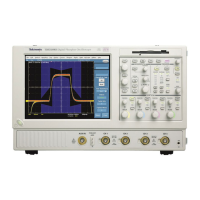232
Autoset Considerations
Autoset acquires samples from the input signal and attempts to take the following actions based on
the input data:
Evaluate the amplitude range of the input signals and set the size and vertical offset of the
vertical acquisition window to acquire the signal with good resolution, but without clipping.
Set the trigger to the approximate midlevel of the signal being Autoset and switches to edge
trigger mode.
Evaluate the signal transitions and set the horizontal scale to produce a waveform display of 2
or 3 cycles of the input signal.
Sometimes Autoset cannot produce a correct display due to the nature of the input signal. If so,
you may have to adjust the scale, trigger, and acquisition controls manually. Some conditions that
can cause Autoset to fail are:
No signal present
Signals with extreme or variable duty cycles
Signals with multiple or unstable signal periods
Signals with too low amplitude
No recognizable trigger signal
Signals with a frequency ±20 Hz
Signals with a frequency above the bandwidth of the instrument
Horizontal Acquisition Window Interrelated
Parameters
Horizontal Scale, Record Length, Sample Interval, and Resolution are related parameters that
specify the horizontal acquisition window. Because the horizontal acquisition window must fit in
the 10 horizontal division display, for most cases, you can set the Time Duration of the horizontal
acquisition window (10 divs x the scale setting) as described below. By also setting a Record
Length in samples, you indirectly set the Resolution, Sample Interval, and Sample Rate for the
horizontal acquisition window (waveform record). The relationship between these horizontal
elements is:
1 Time Duration (seconds) = 10 divs (window size) x Horizontal Scale (sec/div)
2 Time Duration (seconds) = Sample Interval (seconds/sample) x Record Length (samples), where
Time Duration is the horizontal acquisition window time duration, and
Sample Interval (sec/sample) = Resolution (sec/sample) = 1/Sample Rate (samples/sec)
Note that it is the Sample Interval that changes to accommodate the window Time Duration (and
its scale setting) and the Record Length setting. These elements behave as follows:
If the Record Length or Time Duration change, the Sample Interval will vary to accommodate
the change. The Sample Interval can vary up to the highest Sample Rate, (this corresponds to
the lowest Sample Interval, and the highest Resolution).
If the Sample Interval reaches its lower limit, the Record Length must decrease if the Time
Duration decreases (you set faster scale settings), or Time Duration must increase (forcing
slower scale settings) if Record Length increases (you set longer record lengths). The
equation becomes:
Maximum Record Length = Time Duration ÷ Min Sample Interval

